If you want the best dessert topping in the world…. you HAVE to make cajeta. Dessert topping, flavoring for your coffee, a spoonful for your mouth…whatever you decide to do with it, it’s worth the time. Cajeta is basically a dulce de leche or caramel made from goat’s milk and sugar. The milk is heated until the sauce thickens, browns, and gets super tasty for your mouth. I have made plenty of cajeta, but since I got back from Mexico in February, I have been making it in a copper pot, also known as a cazo de cobre. It is a traditional way to make cajeta, and really helps to speed the process because of the excellent conduction and distribution of heat. If you don’t have a copper pot, you can use a heavy pot as long as it’s not cast iron.
On to the recipe… First thing’s first… you need some goat milk. Lucky me, I live on a goat dairy. For my recipe, I used a gallon of milk. It condensed down to about two and a half pints. Here’s all the ingredients you will need:
- 1 Gallon goat milk
- 4 Cups of sugar
- 1 Tablespoon of vanilla extract
- 1/2 teaspoon of baking soda disolved in a tiny bit of tepid water
Pour your milk into your pot and add the sugar and vanilla. Turn the heat on medium and stir it all up.
Heat the milk to a nice simmer… stir frequently. Add the baking soda and water mixture. You may want to take the pot off the heat because it will bubble up when you put in the baking soda. I just add it very slowly and it doesn’t foam up too much.
Keep simmering… and stirring…
Slowly, the milk will start to evaporate and the sauce will begin to thicken.
Keep stirring often.
When it is as thick and dark as you like it, remove it from the heat. I have found that I like mine very thick and very brown. If you want your sauce to be thinner… stop sooner. Thicker? Stop later. Just don’t let it burn… and keep stirring.
It’s all a matter of your taste.
When it’s done, pour it into a heat safe pitcher (or straight into heated jars). Then pour into some canning jars and store in your fridge. I like to take a part of each batch and mix it with some nice bourbon.
This photo is from a previous batch that was thinner and lighter. Half of the batch we mixed with some Eagle Rare, a very tasty bourbon. (We didn’t use the whole bottle in the cajeta… really) Enjoy!
- 1 Gallon goat milk
- 4 Cups sugar
- 1 Tablespoon vanilla extract
- ½ teaspoon baking soda mixed with a bit of tepid water
- Mix the milk, sugar, and vanilla in a heavy non-cast iron pot.
- Heat on medium to a simmer, stirring frequently.
- Add the baking soda *SLOWLY* while stirring.
- Keep heating and stirring frequently until the cajeta is the color and consistency you want.
- Mix with some bourbon (or something else) if you want.
- Pour into canning jars.
- Keep in refrigerator.

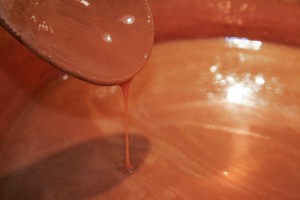
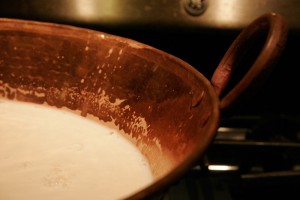
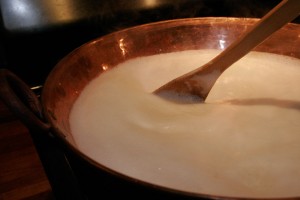
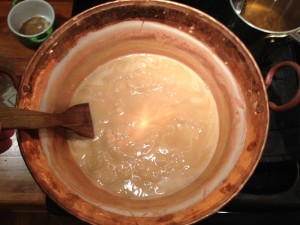
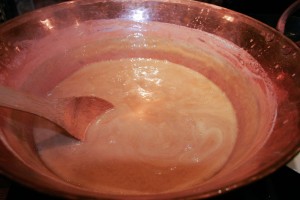
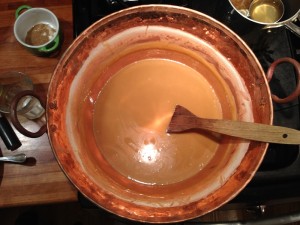
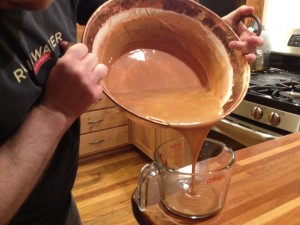
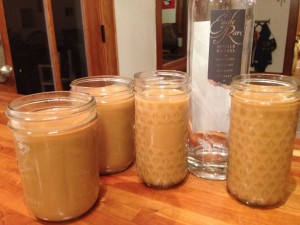
I’ll be honest: not sure which looks more amazing, the cajeta or the Eagle Rare? So I should probably try both :)
How long did it take to make? Stirred constantly or frequently? Oven temp? :) looks yum!
Stovetop temp varies from oven to oven, but you want a fast simmer, not a rolling boil. This batch was 1 gallon of milk and it took 2 hours. Smaller batches can go faster. Stir frequently at first, then more and more frequently as it thickens so that you don’t burn any on the bottom of your pot.
Thanks for the quick reply :) I am gonna go milk the goats and try this today!
Pingback: Strawberries and Cream Jam – Strawberry Jam with a Twist of Vanilla | Hammer on Rye
Pingback: Do you know anyone that drinks goat milk? | Home Grown Farming .com
I love your post. Would you consider being a guest blogger at cheesemakinghelp.blogspot.com (the blog for New England Cheesemaking Supply )
Have you ever canned this so you didn’t have to keep it in the ref (thinking Christmas gifts)? If so, would a plastisol lined lide (no button) work in a 20 min water bath?
Found directions: 20 min hot water bath canning. Works great
What did you do to your copper pot to prepare it for use? My mom brought me a copper pot from Mexico and several people said I should “cure” it first. Did you cure your copper pot? Cari
Is it necessary to pasturize the milk first? I’ve read several instructions and one says yes, others don’t say so.
How much do you end up with at the end when you start with a gallon of milk?